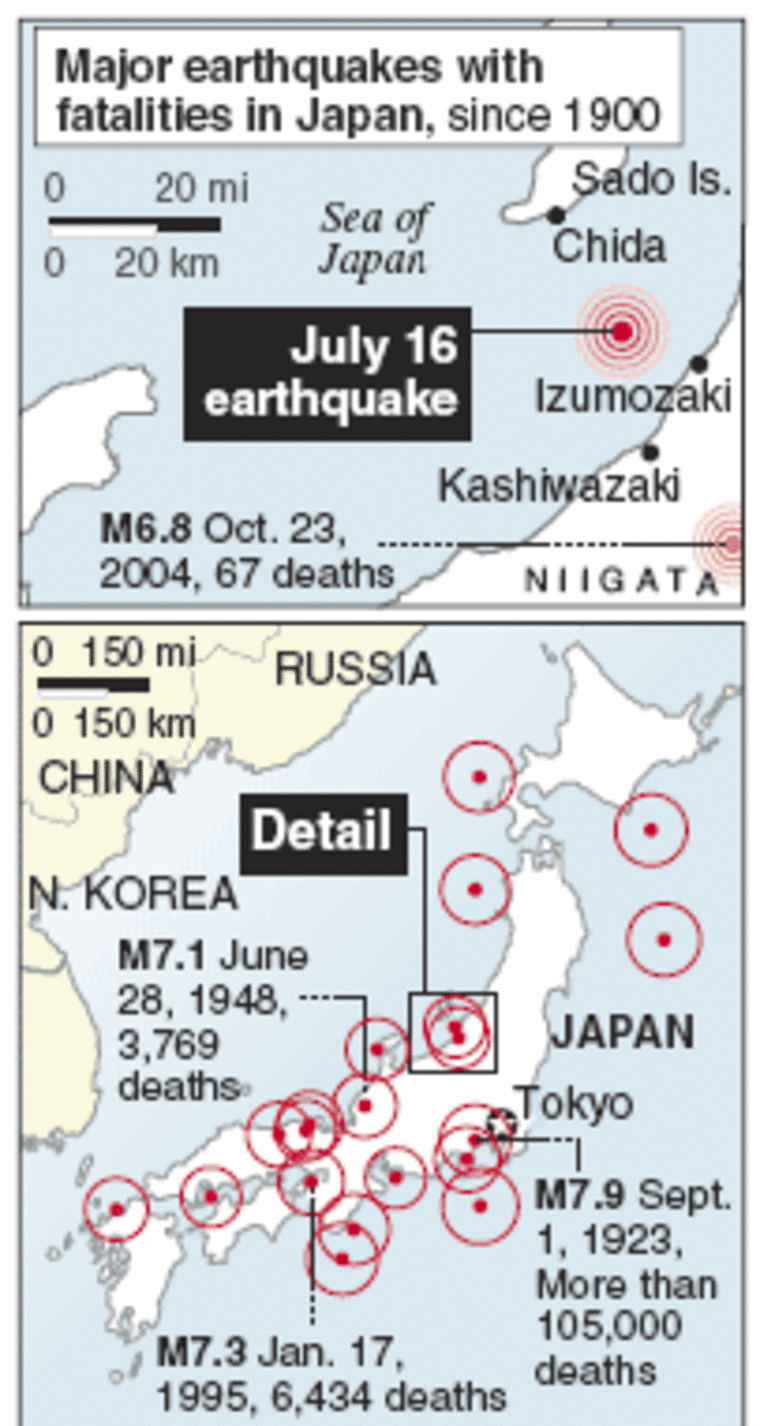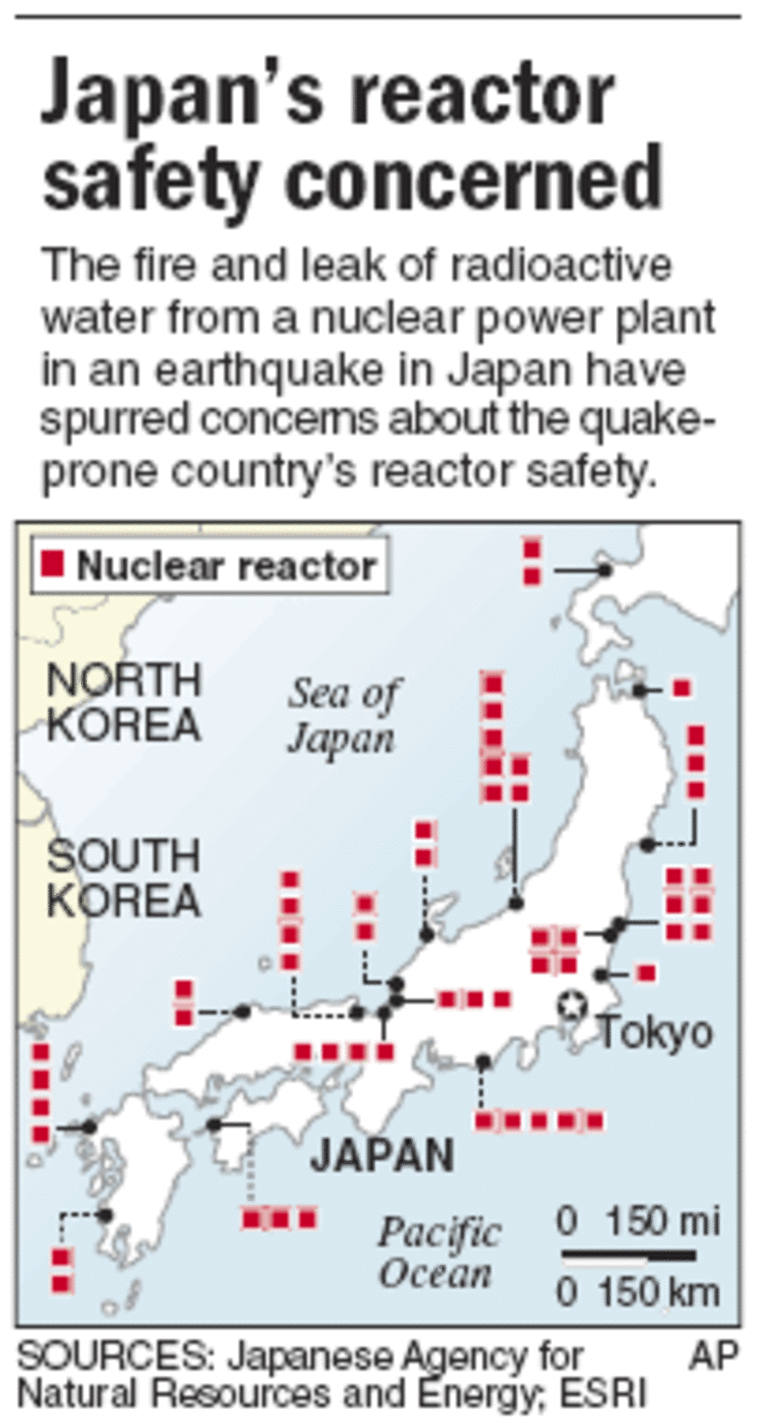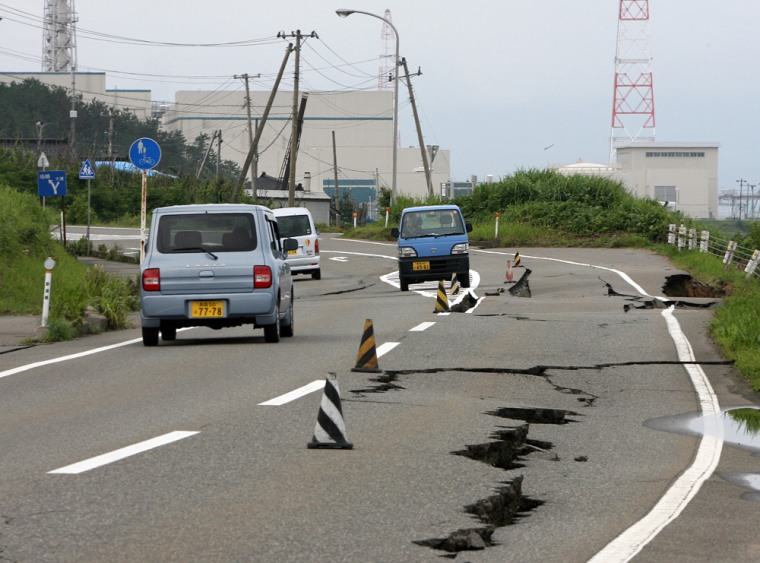A top power company official defended safety standards at an earthquake-ravaged nuclear plant Wednesday, even as the company said a radioactive leak was bigger than first reported and the mayor ordered the plant be shut down until its safety could be confirmed.
Plant operator Tokyo Electric Power Co. announced that a leak of radioactive water into the Sea of Japan was actually 50 percent bigger than initially announced Monday night. But the levels were still well below danger levels, it said.
“We made a mistake in calculating the amount that leaked into the ocean. We apologize and make correction,” the statement said. Spokesman Jun Oshima said the amount was still “one-billionth of Japan’s legal limit.”
Hiroshi Aida, mayor of Kashiwazaki, a city near the epicenter that is home to the plant and 93,500 people, ordered operations at the plant halted Wednesday for “safety reasons.”
'Worried'
“I am worried,” he said. “It would be difficult to restart operations at this time. ... The safety of the plant must be assured before it is reopened.”
Kashiwazaki-Kariwa is the world’s largest nuclear plant in power output capacity. Signs of problems after Monday’s quake came first not from the officials, but in a plume of smoke that rose up when the quake triggered a small fire at an electrical transformer.
It was announced only 12 hours later that the magnitude 6.8 temblor also caused a leak of about 315 gallons of water containing radioactive material. Officials said the water leak was well within safety standards. The water was flushed into the sea.
Later Tuesday, it said 50 cases of “malfunctioning and trouble” had been found. Four of the plant’s seven reactors were running at the time of the quake, and they were all shut down automatically by a safety mechanism.
Tsunehisa Katsumata, president of plant operator Tokyo Electric Power Co., toured the site Wednesday morning, declaring it “a mess” and apologizing for “all the worry and trouble we have caused.”
“It is hard to make everything go perfectly,” he said. “We will conduct an investigation from the ground up. But I think fundamentally we have confirmed that our safety measures worked.”
Across town, more than 8,000 residents hunkered down for their second night in shelters. The death toll — nine, with one person missing — was not expected to rise significantly. Most of the newer parts of town escaped major damage.
For residents, thousands of whom work at the plant, the controversy over its safety compounded already severe problems, which included heavy rains and the threat of landslides, water and power outages, and spotty communications.
Aftershock fears
“Whenever there is an earthquake, the first thing we worry about is the nuclear plant. I worry about whether there will be a fire or something,” said Kiyokazu Tsunajima, a tailor who sat outside on his porch with his family, afraid an aftershock might collapse his damaged house.

“It’s frightening, but I guess we are used to it,” said Ikuko Sato, a young mother who was spending the night in a crowded evacuation center near her home, which was without water or power.
“It’s almost the summer swimming season,” she said. “I wonder if it’ll be safe to go in the water.”
The area around Kashiwazaki was hit by an earthquake three years ago that killed 67 people, but the plant suffered no damage.
55 nuclear reactors
The malfunctions and a delay in reporting them fueled concerns about the safety of Japan’s 55 nuclear reactors, which have suffered a string of accidents and cover-ups. Nuclear power plants around Japan were ordered to conduct inspections.
The plant in Kashiwazaki-Kariwa, 135 miles northwest of Tokyo, eclipsed a nuclear power station in Ontario as the world’s largest power station when it added its seventh reactor in 1997.
The Japanese plant, which generates 8.2 million kilowatts of electricity, has been plagued with mishaps. In 2001, a radioactive leak was found in the turbine room of one reactor.
The plant’s safety record and its proximity to a fault line prompted residents to file lawsuits claiming the government had failed to conduct sufficient safety reviews when it approved construction of the plant in the 1970s. But in 2005, a Tokyo court threw out a lawsuit filed by 33 residents, saying there was no error in the government safety reviews.
Environmentalists have criticized Japan’s reliance on nuclear energy as irresponsible in a nation with such a vulnerability to powerful quakes.
“This fire and leakage underscores the threat of nuclear accidents in Japan, especially in earthquake zones,” said Jan Beranek, a Greenpeace official in Amsterdam. “In principle, it’s a bad idea to build nuclear plants in earthquake-prone areas.”
Nearly 13,000 people packed into evacuation centers in the quake zone, according to the Fire and Disaster Management Agency. By nightfall, the number dropped to about 8,200.
Nine killed
Nine people in their 70s or 80s were killed, and 47 were seriously injured. About 450 soldiers to sent to clear rubble, search for survivors under collapsed buildings, and provide food, water and toilets.

About 50,000 homes were without water and 35,000 were without gas, local official Mitsugu Abe said. About 27,000 households were without power.
Japan has a history of nuclear accidents, some of them deadly.
In 2004, five workers at the Mihama nuclear plant in western Japan were killed and six were injured after a corroded pipe ruptured and sprayed plant workers with boiling water and steam. The accident was the nation’s worst at a nuclear facility.
The U.S. Nuclear Regulatory Commission requires that nuclear plants be built with the capacity to withstand the strongest earthquake to hit its site within 100 years. In a “safe shutdown earthquake,” the chain reaction in the reactor stops, but the cooling system keeps running so excess heat is carried away from the core.
William Miller, a professor of nuclear engineering at the University of Missouri, said the Kashiwazaki-Kariwa plant “did what it was supposed to. It shut down.”
Although its operator said there were leaks, Miller called the amounts he had heard were “so small as to be negligible.”
However, David Lochbaum, director of the Nuclear Safety Project at the Union of Concerned Scientists, noted that fire and loss of power, both of which occurred at Kashiwazaki-Kariwa, are the two most likely causes of meltdowns at nuclear facilities.
